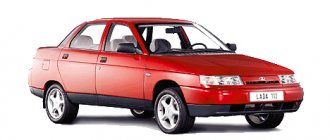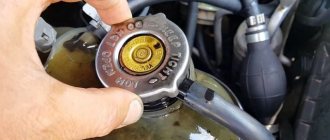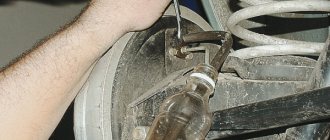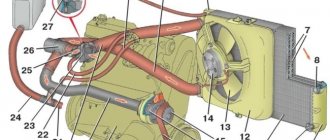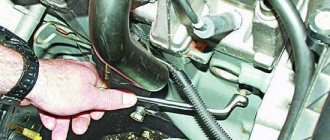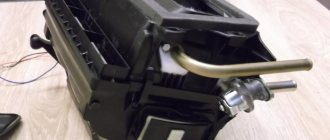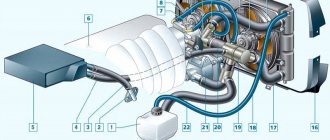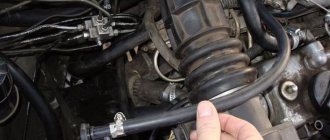Car maintenance involves carrying out various technical procedures. One of these activities is replacing the coolant. Yes, you say, there are antifreezes that you can fill in and not think about this problem for ten years.
I would not advise taking the operation of the cooling system so lightly, because its malfunctions can lead to serious expenses. It is better to regularly inspect and, if necessary, change the composition.
However, this is not what we are talking about. As it turned out, many of my clients turn to the service station for a banal and even funny reason - they do not know how to drain the antifreeze of the cooling system, or rather, they have no idea about the location of the drain plug. Let's talk about this in more detail. In the article I will tell you where, what is located and how to proceed when you need to prepare your car for filling with fresh refrigerant.
When to change engine oil
If the operating mode of the equipment is normal, it is recommended to follow the procedure intervals established by the manufacturer. Usually the information is given in the technical documentation that accompanies the vehicle. A decrease is unacceptable, as is an increase in the specified period of time. You shouldn’t relax, even when the canisters themselves indicate an extended period.
But sometimes replacement needs to be done more often than indicated in the instructions. This applies to the following circumstances:
- Operating a vehicle in an atmosphere with pollution and large amounts of dust.
- Use of low quality fuel.
- Reduced intervals between stopping the power unit and starting it. A maximum of half an hour should pass between these moments. Otherwise, the requirements are violated.
- Operating the machine in urban environments, with long periods of movement in traffic jams.
- Motor operation under high loads.
Motor oil is an indispensable part in the operation of a car.
Any such circumstances require a reduction in time by a quarter, or even longer periods.
Let's sum it up
Any car can be serviced in a garage, but this process should be approached with professional knowledge. Sometimes it's easier to pay a professional a small service fee than to cause irreparable or costly problems to your vehicle. Therefore, think about whether there is a need for independent work, or whether you can entrust a certain process to professionals.
Changing antifreeze does not present any difficulties or problems. The only task will be to follow the manufacturer's recommendations. Also, do not forget about the general maintenance requirements for modern vehicles. Have you ever changed the coolant in your car yourself?
When creating any mechanical internal combustion engine, the designer is faced with two opposing problems: firstly, it is necessary to ensure the injection of a certain temperature necessary for the correct operation of the power unit, and secondly, it is necessary to contain the temperature rise at the optimal level.
It is to solve the problem of controlling the engine temperature at the level of optimal viscosity of fuel and lubricants that a cooling system (SOD) was developed. The evolution of mechanical engineering has shown that the liquid system, which is currently equipped with all manufactured cars, has the highest heat transfer rates.
Therefore, the question of how to drain antifreeze from a VAZ 2114 with your own hands is quite relevant for car enthusiasts of this model.
Oil change steps
The manufacturer indicates the volume of liquid in the accompanying instructions. But it is recommended to use a dipstick to check the oil level, since the ability to completely drain is not supported by all models. When the engine is warm, the indicators always increase; those who are interested in the question of how to properly change engine oil should also remember this.
Preparation work
The first step is to prepare the necessary equipment for changing the fluid:
- It will be dark under the car, so you can’t do without a flashlight.
- Two keys are also required. Using one, unscrew the drain plug, and with the second, remove the oil filter.
- To collect the waste you will need a separate container. You can use bowls cut into canisters. The main thing is that the product fits under the car and is able to accommodate the entire volume.
- The canister itself contains new oil. You need to take it with a small reserve in volume.
- New filter that suits a specific car.
Replacing the filter
Filters are used to clean liquids from various impurities and particles that make further operation difficult. These parts begin to clog after 8 thousand kilometers. If the replacement is not made in time, the bypass valve opens, which causes a lot of dirt and foreign particles to end up in the engine. There may be no external signals, but in this case premature wear occurs.
Fill the new filter with motor lubricant up to half the volume. There must be a rubber band on the outer body of the device. Then the first launch will be softened.
Engine oil drain procedure
Procedure for draining the oil
The standard procedure for replacing fluids assumes that draining is done as follows:
- The machine is installed on a flat surface. An overpass or inspection hole is the best option. Some people prefer to drive vehicles on top of bricks or other building blocks. Then the front of the car rises, which makes it easier to drain the liquid. But even in this case, the waste will not flow out of the engine completely.
- Setting the handbrake or “parking” mode makes it easier to lock the vehicle in one position. The main thing is that the car does not slide to the side; only in this case the driver’s safety is ensured.
- The drive needs to be warmed up to operating temperature, and then wait a little. This will allow the parts to cool down and the owner to be protected from instant burns.
- Protective panels block access to the oil pan. You also need to get rid of such parts.
- To prevent oil splashing, the collection container must be installed in advance.
- The plug in the engine sump is unscrewed. First, a wrench is used, then the work is done manually. You need to watch the metal or plastic gasket on the plug - it may fall.
- It only takes a few minutes to drain the entire volume of old fluid. If a small part of the waste fluid remains inside, this is normal.
- If there is a lot of sediment in the old oil, then the engine needs to be flushed before adding new material.
- Next comes replacing the oil filter. What is needed to change the oil in an internal combustion engine has already been listed above.
Filling order
The liquid is poured inside after the old oil is completely drained and the filter is replaced. The volume of new material must correspond to what is written in the technical documentation accompanying the car.
Only minor changes in volume are permissible - they will not lead to serious consequences. But overfilling or underfilling can become a problem if it is noticeable. Insufficient oil, for example, often leads to overheating of engines. Strong overflow leads to the fact that the oil seals are squeezed out of the crankshaft.
Which oil is recommended to choose?
Most modern engines use types of oils that are classified according to several criteria:
- Tolerance or quality standard of automobile manufacturers.
- Quality according to API or ACEA system.
- Viscosity, according to SAE classification.
- Depending on the chemical composition. This characteristic allows us to distinguish between synthetic and semi-synthetic, mineral varieties of oils.
Oil fill
Many modern cars have so-called boosted engines. Synthetic motor oils are the optimal choice for lubrication. This means that the composition contains only synthetic components. High stability of physicochemical properties has become the main advantage for the compositions. The oil change procedure remains standard.
Oils of synthetic origin continue to cope with functions regardless of the conditions under which a particular engine is operated.
There are other tips that are given to car owners before changing the fluid.
- You cannot skimp on quality. That's why most drivers prefer synthetics.
- Mineral fluids are changed every 7-8 thousand kilometers after a planned procedure. Synthetics can be changed every 15 thousand kilometers. But these recommendations correspond to European roads, where conditions are almost ideal. In the case of RF, it is recommended to carry out the procedure earlier than the interval specified earlier.
- The engine mixture is also negatively affected by factors such as extreme driving style and spending time in traffic jams. The liquid thins out if the surrounding temperature rises. Because of this, the protective properties begin to decrease. And it is necessary to change the engine oil in a shorter period of time.
How to drain oil from an engine?
From our material you will learn how to drain oil from the engine, why overflow occurs and how to drain excess, how to pump oil through the dipstick if draining is impossible.
Changing the oil is a fairly simple procedure, and many car enthusiasts do it themselves. However, if you don’t know some of the nuances, you can make a common mistake: overfilling the lubricant above the permissible level. The option “you can’t spoil the porridge with oil” is not suitable for the engine. Excess can create additional problems:
- The balance of the air-to-fluid ratio in the crankcase will be disrupted. This results in excess lubricant pressure. Oil seals designed for the standard size are not able to withstand the pressure and become deformed. As a result, we get leaks on the shafts coming out of the motor.
- Excessive pressure can damage the oil filter element. As a result, until the next routine maintenance you will be left with virtually no lubricant cleaning
- Excess oil will get inside the piston and overheat, coming into contact with its hot walls. All this carbon deposits fall back into the crankcase and are deposited on the walls in the form of slag. Then the oil lines become clogged.
- The setting of hydraulic valve compensators (they are normally filled with engine oil) or timing chain dampers (for the same reason) may be disrupted.
Why does oil overflow occur?
You have conscientiously drained the waste, replaced the filter, tightened the drain plug and filled in fresh lubricant according to the regulatory instructions. Then you take out the dipstick and observe in horror the level a few millimeters above the maximum. Where did the excess oil come from?
You have filled the amount calculated for an empty (more precisely, dry) engine crankcase. However, they did not take into account the fact that in the cavities, on the horizontal surfaces of the crankcase, and finally, in the hydraulic compensators and dampers, there is a little old lubricant. This “little” can reach 200-400 ml.
Renault Logan oil pan drain plug
Renault Logan cars, which are quite popular in Russia, use drain plugs with a head diameter of 8 millimeters. The metal sealing ring has a rubber layer around its inner circumference. This allows you to avoid even the smallest leaks.
When changing the oil, the gasket also changes. As a rule, the O-ring is a disposable attribute of the drain plug. During operation, rubber can become damaged, and reusing a damaged part will lead to fairly large oil losses.
How to drain excess oil from the engine?
It would seem that the answer is on the surface (more precisely, under the bottom). Open the plug, drain the oil, and fill it back in a smaller quantity. From a technical point of view, this is the right decision, but draining the lubricant while keeping it clean will not work. Therefore, we remember this method as a last resort and never use it. In general, just drain the excess, not all the oil.
Another option from the treasury of garage craftsmen (nevertheless, tested in practice) is draining the oil filter. If you tilt the car strongly (driving onto a curb) in the direction opposite to the location of the filter, you can easily unscrew it and pour out the liquid. Up to 200 ml of oil is placed in the filter jar. Then carefully put it in place.
The method is not suitable for all cars. In addition, there is a small risk of contamination.
The excess oil is carefully drained through the plug on the crankcase. Just don't turn it off completely. It is enough to unscrew to the middle of the thread, and the oil will begin to flow out in a thin stream. The method requires patience, but it is effective and safe for the engine.
Features of spare parts for the Skoda Octavia car
The oil pan drain plug on the Skoda Octavia has a 19 mm head. As for the sealing ring, experts recommend using elements that flatten when tightened. This “effect” achieves a high level of tightness. You can purchase aluminum or copper rings to seal the oil pan drain plug.
There are also plugs for the Octavia that can be unscrewed using a Phillips screwdriver. For each car, this part must be selected individually. There are known cases when the owner purchased a plug for an Octavia, and it “leaked.”
How to pump oil out of the engine if draining is impossible?
The only possible way is a vacuum pump. But these are only available at service stations; to use them in the garage, you will have to shell out a tidy sum. You will have to pump it out through the dipstick; the oil filler neck is not suitable for this.
You can make something like a vacuum pump yourself:
- From a pastry syringe. The pressure is low, but the volume is good. You can pump out 200-300 ml in one go.
- From a medical syringe. The situation is the opposite: excellent pressure, but small volume.
- From a rubber syringe or PET bottle with thick walls. If the container is compressed, back pressure is created when the shape is restored.
How to pump oil out of an engine through a dipstick in a garage?
For example, let's take a medical syringe. Additionally, you will need a tube of the appropriate diameter. You can use an IV kit. In this case, it is easy to control the movement of liquid through transparent stacks, and the hose fits under the syringe. But such a tube is too soft and it is difficult to lower it to the oil level in the crankcase.
You can use a rubber tube: this is used in the windshield washer system. The procedure is quite simple: pump out the lubricant, pouring it into a clean container. Then, checking the level, fill the required amount back if you suddenly overdid it.
Correct algorithm
When a car owner asks about replacing antifreeze, he has to obtain information about how to properly replace the coolant, and in what sequence all actions must be performed.
Usually they start by emptying the cooling radiator located in the front of the engine compartment. It has a similar hole at the bottom, which is closed with a hexagonal head. Armed with a wrench of the appropriate size, you need to unscrew the head outward. If unscrewing turns out to be too labor-intensive, it is better to use the so-called “liquid key”. This will not only make your task easier, but also prevent damage to the radiator housing, which may result in the need to replace it.
If you don’t know how, don’t lie: how to change engine oil correctly
They will immediately spit on you, ostracize you, curse you, and write you a referral to a psychiatrist. Now say the opposite: I never pour oil into the filter when changing. They will do the same to you, only perhaps the sequence will change. In a word, even here a lot of controversy arises, and of such intensity that the election debates in America against their background will seem like children fussing in a sandbox. Therefore, we will present the point of view of professionals: how to change the oil correctly, not ruin the engine, and at the same time, save on a service visit and have fun.
“That’s right - don’t change”
To sort out the issue, I went to a good car service center of the St. Petersburg branch of Largusservice. Of course, they work here not only on Largus, but also on many other cars (although, of course, Largus, Logans and Sanderos are a priority). Just on the lift stood Renault Sandero, undergoing another maintenance. I asked the master a question directly: “How to change engine oil correctly”? The answer is a smile. And the answer that one would expect from a serviceman: “The right thing to do is not to change it yourself. There is a service station for this.” Of course, I chuckled internally (and maybe even externally) and asked: “Why is that?” After all, there is nothing complicated here!
Indeed, this work is not difficult. The vast majority of car enthusiasts are quite capable of it. But there are also cases that seemed funny to me, but sad for the owners of cars that they tried to service on their own. I'll tell you a particularly creepy story. Even two.
Two creepy stories
A man bought a foreign car (I won’t specify which one. Maybe it’s not even a foreign car at all?) Going to the dealer is expensive, but pride does not allow him to go to a service center. And the oil needs to be changed. We've run ten thousand kilometers, it's time to roll up our sleeves. Theoretically, everything is simple, drain the old and fill in the new.
In practice, the owner of the car still came to the service center, only with another problem: the gearbox was humming. We listened and made sure it was buzzing. The first step was to check the oil level in it. The gearbox turned out to be “dry”. The service asked: what was done to the car? Nothing, the owner replies, he just changed the engine oil. Myself. With my own hands. These same, dudes, golden hands.
Yeah, there's a clue. They started checking the engine oil. In general, the picture is clear: I unscrewed the drain plug from the crankcase and added oil to the engine. Three liters. Why check its level using the dipstick? That's right, no need! The manual says three liters - I measured it out and poured it in. Result: the box is empty, there are six liters of oil in the engine. We managed to save the box, filled it with oil, and the noise went away. And we were lucky with the engine; the seals didn’t get squeezed out. We drained six liters of a cocktail of old and new oil and poured in new oil.
Attention, question: how can this be done if during the replacement process it was necessary to unscrew the filter (the oil would still leak out at least a little) and check the oil level at least twice on the dipstick? So I don’t know.
Well, a much more prosaic picture. I have a friend who heard a knocking noise in the engine a few kilometers after the replacement. He did everything correctly, but forgot to tighten the drain plug and check the level after replacing it. Here the price of inattention turned out to be higher.
These are the consequences (let's face it - rare) that can happen if you don't pay due attention to the operation. Therefore, the service technician is right about something: if your impulsive nature does not allow you to approach the work with due attention or you confuse the gearbox housing with the internal combustion engine housing, then it is better to go to a service center. Not convinced? Then let's move on.
Suck? Blend in!
There are many ways to change the oil. It has long been the norm at many service stations to use vacuum units for oil changes. This thing allows you to suck out most of the oil through the dipstick hole. What is so good about it? Almost everything, but only for the workshop owner: a lift or at least a pit is not needed, the crankcase protection does not often have to be removed (it all depends on the location of the oil filter), there is no need to mess with the drain plug, there is no need to wait until the oil drains completely.
Methods for changing engine oil
by mexanic May 22, 2015
Oil contamination causes wear and reduced service life of the rubbing parts of the machine. The power and reliability of the engine depends on its composition. Therefore, it is so important to observe the replacement periods recommended in the operating instructions for cars, taking into account real conditions.
Changing the oil occurs in several stages:
- purchasing the necessary materials (high-quality oil, flushing and filter);
- washing stage;
- draining used oil;
- change the filter and fill in new oil.
It should be noted that oil changes in a diesel engine will occur more often than in a gasoline or gas engine.
This procedure is needed to clean the oil channels, remove carbon deposits and carbon deposits; it provides a larger volume of used oil.
There are two types of rinsing - soft and fast.
The latter type is poured into the oil just before changing it, the flushing is left for 10 minutes and it cleans the engine. It is used regularly, from the first days of car operation.
Soft flushing is poured into the engine, and for it to have time to take effect, you must drive at least 200 km. She handles car parts gently and carefully. This type of washing is especially important for older brands of cars.
For cars running on gasoline, special flushing compounds can be used. But if the engine is new and high-quality motor oil was used, then there is no need for flushing; the lubricants already contain detergent additives.
After flushing, the engine oil should be changed.
During operation, the engine collects various contaminants from roads or low-quality fuel. They settle in the motor lubricant and oxidize it, so it must be changed regularly.
Classic method ↑
To drain, you will need the following tools: an oil filter wrench, a combination wrench, a funnel, a container, a canister, a flashlight, and a rag.
Changing the engine oil will occur by draining it through a special hole located on the oil pan. It is carried out in several stages.
- The motor is warmed up to normal operating temperature, otherwise mechanical inclusions will remain at the bottom. Then the drain plug located on the oil pan is unscrewed, after placing a container to collect the lubricant. You can reduce the draining time by removing the cap from the filler neck.
- When using flushing, it must be refilled after the oil has been completely removed. Start the engine at idle speed, wait a little, then drain. Using a special wrench, unscrew the oil filter device. And the drain plug is wrapped back into the pan, after wiping it with a clean rag.
- It is advisable to replace the old gasket with a new one. Before installing a new filter, you need to fill it with oil. You can only screw the filter into place by hand to protect yourself from difficulties when removing it later.
- Fresh oil is being added. The cover is removed from the engine, and new lubricant is poured in using a funnel. Level control is carried out using a dipstick; it should be between the MIN and MAX marks. After filling, the cover is installed in place.
- The oil filter is changed.
- Start the engine and carefully check whether oil is leaking. The oil indicator should be in the “normal” position.
- access to the bottom of the car, as well as to its chassis, is open. You can at the same time perform diagnostics of the car’s chassis;
- Complete drain of oil, no residue.
- long process compared to express replacement;
- splashing of oil when draining around the machine, which leads to contamination and the threat of dirt getting into the engine.
Filling with fresh coolant
The final step is to fill in fresh coolant in accordance with all recommendations and in compliance with the proportions in the case of self-diluted concentrate.
- Pour new coolant into the expansion tank, filling it to about.
- Next, it is recommended to tighten the cap on the tank, and the engine itself can be started. Be sure to pay attention to the fact that the stove in the cabin must be turned on.
- As a result of the first start of the engine, the pump will begin to work, the liquid will be evenly distributed throughout the system, and the level in the tank will noticeably decrease. This is due to the fact that when the car is turned off, when filling antifreeze, all pipelines and the total volume of the cooling system cannot be completely and immediately filled.
- When the level in the tank drops to a minimum, the engine is turned off. Then you will need to add coolant again to the maximum level by unscrewing the tank cap again. After topping up, screw the cap on and start the engine again. This procedure must be repeated until the fluid level in the expansion tank stops decreasing after a test run of the engine.
- It is also separately recommended to carry out a final check of the coolant level after replacement after 1-2 days of using the car.
Express method ↑
The equipment is divided into professional and home use. Professional systems are equipped with electric compressors; they have containers with a capacity for several replacement cycles. They differ in quick-release hoses with special attachments for different engines.
To perform an express replacement of a house, you need autonomous equipment. It is a small container filled with air, the volume of which is discharged using a hand pump. The reservoir is intended for one cycle, reuse occurs after the container is completely cleaned.
With this method, the used composition is pumped out through a hole where the oil level dipstick is inserted. The process is carried out in several stages.
- The engine must be warmed up to operating temperature so that the lubricant flows into the crankcase.
- The probe is removed from the hole, then the tube of the pumping device is inserted. It is lowered until it touches the surface of the engine. The air in the apparatus is discharged using a hand pump or compressor. Due to the pressure difference, the oil is drawn out.
- After pumping out the lubricant, the tube is removed. Then the filter is changed. The presence of a nozzle on the tube is checked so that it does not get lost when draining inside the motor.
- Fresh lubricant is poured in, the level is controlled with a dipstick, which is then installed in place.
- Replacing the oil filter.
- you can do without a special key for the drain plug;
- express - replacement takes less time than regular draining;
- Changing the engine oil occurs in the normal position of the machine, there is no need for a lift;
- The process is environmentally friendly and does not affect the environment.
- the tube is unreliable, it can be broken off or the nozzle can be left inside;
- Less used lubricant is drained than with the first method.
Each car enthusiast chooses for himself how to change the engine oil. You can contact a service station or do it at home, knowing the necessary techniques and choosing the appropriate method. But it should be noted that the best option is to alternate express replacement with the classic method.
Features of the VAZ 2114 engine cooling system
To understand how to drain antifreeze on a VAZ 2114, you must have basic knowledge of the operating principles of this system. The basis of the SOD design is a radiator, which provides discrete circulation of coolant (antifreeze/antifreeze), through channels that are cooled by a counter flow of air. Increasing the efficiency of the process is achieved by narrowing the radiator channels and increasing their number, which increases the useful heat transfer area.
In addition to the radiator, the SOD includes:
- pump - a special pump that, using an impeller, pumps the necessary pressure into the SOD in the right direction, which makes the system forced;
- fan - which on the fourteenth model has four blades. When the temperature rises to a certain point, it is activated by a special electric motor. During its operation, the air receives additional kinetic acceleration, cooling and increasing the efficiency of the SOD;
- heating system - is a tubular body of the radiator, the air from which is directed into the cabin;
- expansion tank - is a special container that performs a compensatory function for the relative thermal change in the volume of coolant;
- thermostat - a two-valve mechanical unit that regulates the release of liquid into the small and large circles, so the main valve opens at 87 and the additional valve at 102 degrees, respectively;
- temperature sensor - evaluates the operation of the system, transmits information to the on-board computer, from where the operation of the ODS is corrected and signals are sent to the driver on the dashboard;
- hydraulic passage system - consisting of a variety of tubes, pipes and channels inside the engine.
